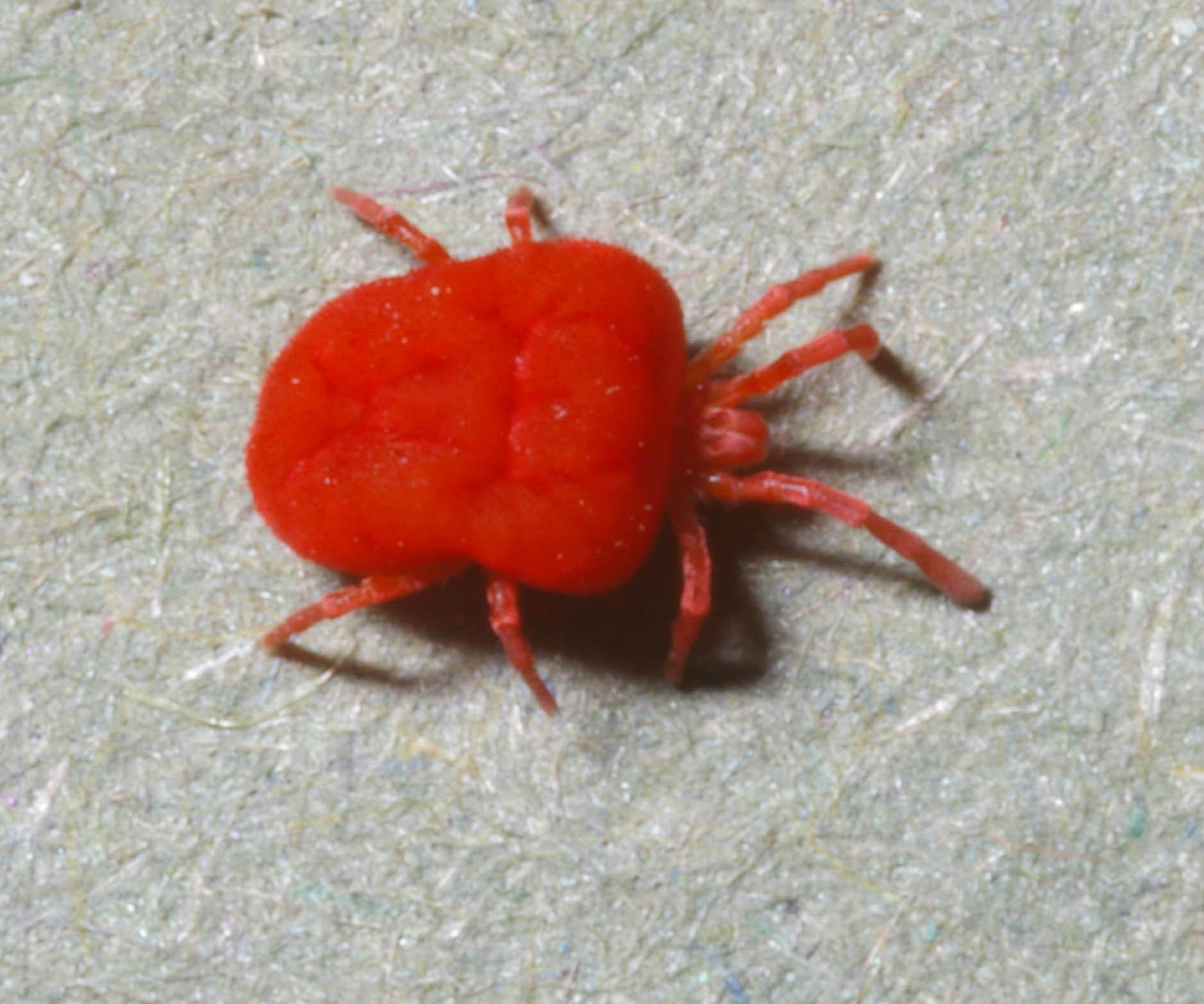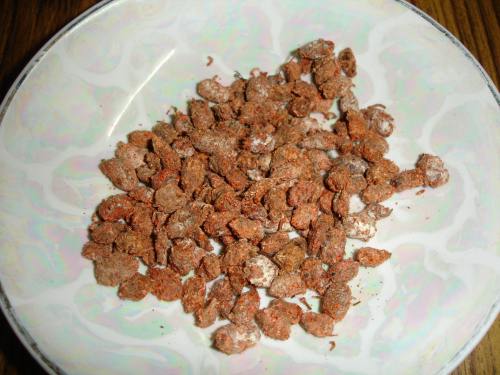|
Trombidiidae
Trombidiidae, also known as red velvet mites, true velvet mites, or rain bugs, are small arachnids (eight-legged arthropods) found in plant litter and are known for their bright red color. While adults are typically no more than in length, some species can grow larger and the largest, including the African ''Dinothrombium tinctorum'' and Indian ''Trombidium grandissimum'', may exceed . This also makes them the largest mites, if disregarding ticks engorged after feeding; unlike those, ''D. tinctorum'' and ''T. grandissimum'' are harmless to humans. Their life pattern is in stages similar to other members of the Prostigmata: egg, pre-larva, larva, protonymph, deutonymph, tritonymph and adult (male or female). They usually have only one breeding cycle per year.Zhang, Zhi-Qiang (1998) Biology and ecology of trombidiid mites (Acari: Trombidioidea) Experimental & Applied Acarology 22:139–15PDF/ref> They are active predators as grown adults. As larvae they are often parasites of ... [...More Info...] [...Related Items...] OR: [Wikipedia] [Google] [Baidu] |
Trombidium Grandissimum
''Trombidium grandissimum'', commonly known as the giant red velvet mite, is a species of mite in the genus ''Trombidium'' in the family Trombidiidae. This common mite is Endemism, endemic to northern and central India, especially in the central plateau, and it primarily inhabits arid regions. ''T. grandissimum'' live on the ground and often hidden among soil, but is commonly seen during the rainy season or after recent rain events, and therefore (along with some other red velvet mite species) has the nickname of "rain bug". Description ''Trombidium grandissimum'' is one of the largest species of red velvet mite, with adults typically being about long. It is bright red and has a soft cushioning skin covered with fine hairs. A study of another species, the spider mite ''Tetranychus urticae'', showed that the red color was caused by carotene, which was beneficial for their hibernation. ''T. grandissimum,'' belonging to the same order as spider mites, spend an extensive period of ... [...More Info...] [...Related Items...] OR: [Wikipedia] [Google] [Baidu] |
Trombidium
''Trombidium'' is a genus of mite with about 30 described species. Species * '' Trombidium auroraense'' Vercammen-Grandjean, Van Driesche & Gyrisco, 1977 – New York * '' Trombidium breei'' Southcott, 1986 – Europe (host: ''Agapetes galathea'', Lepidoptera) * '' Trombidium brevimanum'' (Berlese, 1910) – Europe * '' Trombidium cancelai'' (Robaux, 1967) – Spain * '' Trombidium carpaticum'' (Feider, 1950) – France, Romania * † '' Trombidium clavipes'' Koch & Berendt, 1854 – Fossil: Oligocene * '' Trombidium dacicum'' (Feider, 1950) – Poland, Romania * '' Trombidium daunium'' (Paoli, 1937) – Italy * '' Trombidium fturum'' Schweizer, 1951 – Spain, Switzerland * '' Trombidium fuornum'' Schweizer, 1951 – Poland, Switzerland, France * '' Trombidium geniculatum'' (Feider, 1955) – Spain, Romania, Poland, Norway * '' Trombidium grandissimum'' (Koch, 1867) - India * '' Trombidium heterotrichum'' (Berlese, 1910) – Europe * '' Trombidium holosericeum'' (Linnaeus, 17 ... [...More Info...] [...Related Items...] OR: [Wikipedia] [Google] [Baidu] |
Allothrombium
''Allothrombium'' is a genus of mites belonging to the family Trombidiidae Trombidiidae, also known as red velvet mites, true velvet mites, or rain bugs, are small arachnids (eight-legged arthropods) found in plant litter and are known for their bright red color. While adults are typically no more than in length, so .... Species The following species are accepted in the genus ''Allothrombium'': * '' Allothrombium adustum'' * '' Allothrombium amiraeli'' * '' Allothrombium angulatum'' * '' Allothrombium athleticum'' * '' Allothrombium chanaanense'' * '' Allothrombium cincindelae'' * '' Allothrombium clavatum'' * '' Allothrombium crassicomum'' * '' Allothrombium delamarei'' * '' Allothrombium dipterae'' * '' Allothrombium epiphyllus'' * '' Allothrombium franklinimuelleri'' * '' Allothrombium fuligineum'' * '' Allothrombium gracile'' * '' Allothrombium guttatum'' * '' Allothrombium incarnatum'' * '' Allothrombium insigne'' * '' Allothrombium lawrencei'' * '' Allothrombium l ... [...More Info...] [...Related Items...] OR: [Wikipedia] [Google] [Baidu] |
Dinothrombium
''Dinothrombium'' is a genus of mites belonging to the family Trombidiidae, which are commonly known as red velvet mites. As suggested by the name, ''Dinothrombium'' are covered in fine hairs and they are bright red, sometimes with markings in paler colors. Their bright colours appear to be aposematic, hinting at their unpleasant taste and smell. They are generally fairly large for their family and the African ''D. tinctorum'', where adults typically are , is one of the largest known species of red velvet mites (and the largest mites, if disregarding ticks engorged after feeding). ''Dinothrombium'' are found in all the world's continents, except Antarctica, often in dry areas, where they spend most of the time underground in the soil or sand, emerging after heavy rain. During this time, they can be conspicuous and numerous. They are harmless to humans and regarded as beneficial because they feed on tiny arthropod Arthropods ( ) are invertebrates in the phylum Arthropoda. Th ... [...More Info...] [...Related Items...] OR: [Wikipedia] [Google] [Baidu] |
Trombidium Holosericeum
''Trombidium holosericeum'' is a species of mite in the genus ''Trombidium''. It occurs in Europe, Asia, and Africa and is commonly confused with other red mite species. Description This species is one of the largest mites in northern temperate zones, with a body length of about ). The soft, brightly red body is covered with fine hairs, giving it a velvety appearance. The small eyes are located on stalks. They have scissor-like chelicerae and their pedipalps are used as touch organs. Its bright red color results from carotenoids, warning predators about the toxicity of the mite (aposematism). Almost nothing is known about the toxic substances used, but they are probably contained within the integument. The specific epithet is derived from Ancient Greek , , "whole" and , , "silken". Biology While adults live freely and are often found wandering about, searching for small animals and insect eggs for food, the larvae try to find a host to attach themselves to, often an insect li ... [...More Info...] [...Related Items...] OR: [Wikipedia] [Google] [Baidu] |
Prostigmata
Prostigmata is a suborder of mites belonging to the order Trombidiformes, which contains the "sucking" members of the "true mites" (Acariformes). Many species are notorious pests on plants. Well-known examples of prostigmatan plant parasites are species of the gall mites ( Eriophyidae, e.g. the redberry mite '' Acalitus essigi''), Tarsonemidae (e.g. the cyclamen mite, '' Steneotarsonemus pallidus''), and the spider mites of the Tetranychidae (e.g. the two-spotted spider mite, '' Tetranychus urticae''). Other Prostigmata live as parasites on vertebrates (e.g. ''Demodex'' mites of the Demodecidae) or invertebrates (e.g. '' Polydiscia deuterosminthurus'' of the Tanaupodidae or the honeybee tracheal mite, '' Acarapis woodi'', of the Tarsonemidae). There are also some forms (e.g. Smarididae) that are predators of small invertebrates – including smaller Prostigmata – yet others have a more varied lifestyle (e.g. Tydeidae) or switch their food sources as they mature (e.g. ... [...More Info...] [...Related Items...] OR: [Wikipedia] [Google] [Baidu] |
Parasitengona
Parasitengona is a group of mites, variously ranked as a hyporder or a cohort, between the taxonomic ranks of order (biology), order and family (biology), family. They are divided into the aquatic Hydrachnidia (water mites) and the terrestrial Trombidia. The latter includes velvet mites and chiggers. Description Many Parasitengona are relatively large (for mite standards) and have a bright red colouration. Other colours include purple, orange, yellow, blue, green and brown. The terrestrial Trombidia are often hypertrichous, meaning they are covered in many irregularly arranged Seta, setae. The chelicerae bases are separate, the fixed cheliceral digit is absent and the movable digit is either hooked or linear. The Pedipalp, palps are often raptorial with a claw-like seta on the tibia. The gnathosoma is retractable within group Erythraeina. The stigmata and peritremes, when present, are between the cheliceral bases. In Trombidia, there is usually one or two pairs of trichobothri ... [...More Info...] [...Related Items...] OR: [Wikipedia] [Google] [Baidu] |
Trombiculidae
Trombiculidae (), commonly referred to in North America as chiggers and in Britain as harvest mites, but also known as berry bugs, bush-mites, red bugs or scrub-itch mites, are a family of mites. Chiggers are often confused with jiggers – a type of flea. Several species of Trombiculidae in their larva stage bite their animal host and by embedding their mouthparts into the skin cause "intense irritation", or "a wheal, usually with severe itching and dermatitis". Humans are possible hosts. Trombiculidae live in forests and grasslands and are also found in the vegetation of low, damp areas such as woodlands, berry bushes, orchards, along lakes and streams, and even in drier places where vegetation is low, such as lawns, golf courses, and parks. They are most numerous in early summer when grass, weeds, and other vegetation are heaviest. In their larval stage, they attach to various animals, including humans, and feed on skin, often causing itching. These relatives of ticks are n ... [...More Info...] [...Related Items...] OR: [Wikipedia] [Google] [Baidu] |
Mite
Mites are small arachnids (eight-legged arthropods) of two large orders, the Acariformes and the Parasitiformes, which were historically grouped together in the subclass Acari. However, most recent genetic analyses do not recover the two as each other's closest relative within Arachnida, rendering the group invalid as a clade. Most mites are tiny, less than in length, and have a simple, unsegmented body plan. The small size of most species makes them easily overlooked; some species live in water, many live in soil as decomposers, others live on plants, sometimes creating galls, while others are Predation, predators or Parasitism, parasites. This last type includes the commercially destructive ''Varroa'' parasite of honey bees, as well as scabies mites of humans. Most species are harmless to humans, but a few are associated with allergies or may transmit diseases. The scientific discipline devoted to the study of mites is called acarology. Evolution and taxonomy Mites are not ... [...More Info...] [...Related Items...] OR: [Wikipedia] [Google] [Baidu] |



